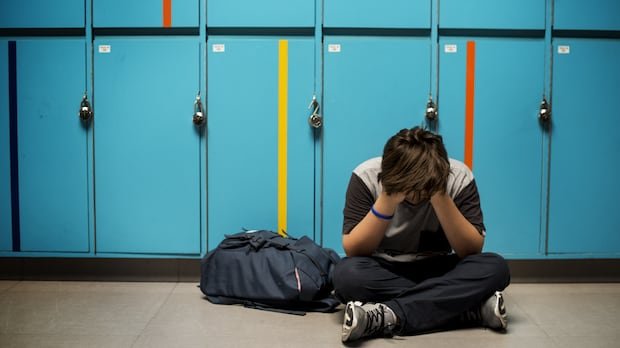A child being bullied mercilessly in the schoolyard. A student with anxiety and ADHD struggling to get into a noisy, crowded classroom. A mortified teenager who had an embarrassing photo shared with his entire grade.
These types of experiences are common. For some children, they make going to school seem impossible.
It’s called school avoidance and sometimes even school phobia. It happens when school doesn’t feel safe and staying home becomes a form of self-protection.
It’s a factor experts say is driving an increase in absenteeism that a CBC investigation shows is happening across the country.
The type of absence that increased the most was reported illnesses, which increased compared to five years ago in all districts that tracked them. In some places, they more than tripled, even taking into account the increase in student numbers.
It’s something Norm Di Pasquale, a Toronto parent and former school board trustee, is very familiar with.
In late October, her 12-year-old son William had missed about 10 days of school. The reason?
“Bullies exist,” William said, sitting on his bed, which is covered in Squishmallows. Pasted on its walls are certificates of achievement: in math, piano, and a Virtue of the Month award for compassion.
“They will say bad things,” William said quietly.
“Sometimes I think, ‘I don’t care, it’s okay, yeah, you said it.’ But sometimes it hurts a little bit..“
William points out that he is small for his age: four feet six inches. This, plus a facial tic, are two of the reasons William says he gets bullied in the schoolyard.
“It’s hard not to twitch. I don’t know how.”
His father, Norm, says the bullying is both verbal and physical.
“When these types of incidents occur, I am assured that there will be an absence the next day.”
William will resist the next morning, Norm explains. He might take a while to get out of bed and get dressed, or complain that he feels sick.
“You don’t always have a clear ideason.… AA father who has to start work, you know, at 9 am, you have a limited amount of clue to convince your child to go to school in the morning.”
Absences as a ‘symptom’
William is far from alone, according to David Smith, a psychologist and education professor at the University of Ottawa who studies school attendance and whose previous work has focused on bullying.
“Every day there are hundreds or thousands of students who don’t go to school because of the bullying they are experiencing,” he said.
Bullying, which can now follow children home through social networks and group chatsis difficult to quantify and is not something that can be tracked in the data obtained by CBC.
Because data on absences is also collected inconsistently across jurisdictions, using descriptors that are often vague and subjective, it’s difficult to get a clear picture of what’s happening, said Natasha McBrearty, who also researches school attendance at the University of Ottawa and is a registered psychotherapist.
“When we think about school attendance, we consider it a symptom of underlying problems that may be happening,” he explained.

These could include physical or mental health issues, lack of transportation, changes in technology that make it easier to learn from home, housing instability or even children having to work to support their families, he says.
What the data shows
CBC News reached out to 46 school districts with student populations of more than 25,000 to request data on the reasons for absences at different ages. We received at least some data from 26 districts across Canada.
CBC News requested the following data for 2018-19 to 2024-25 inclusive, but several districts had different start years:
- Excused absencesincluding religious holidays, professional appointments, school trips, snow days, family events such as funerals, and often illness. These increased over five years in 11 of the 15 districts they tracked. Two districts showed an increase for one age group and a decrease for another. One showed an overall decline and the other had only one year of data.
- Unexcused absencesthat occur for reasons not sanctioned by the province or school district, or absences for which there is no explanation. These increased over five years in 10 of 15 districts, while four showed mixed results at different age levels. One had only one year of data.
- Diseases increased in five years at all ages in 11 of 12 districts that measured it independently. One district had only one year of data.
- Chronic absencewhich generally means the proportion of students who miss more than 10 percent of the school year, or about two days a month. Research has found that it is predictive of negative results later in life. Former CBC reports, which included fewer districts, found that chronic absenteeism had increased in most places beginning with the 2022-23 school year. This analysis shows five-year increases in eight of 19 districts and mixed results among different age groups in six others. Four districts saw overall improvement.
Absences due to mental health or anxiety could fall into any category. If a child is stressed by bullying and complains of stomach pain, it may be reported as an illness. If no one reports the absence, it will be considered unexcused.
“There’s no bully button on the SchoolMessenger app,” Norm explained, referring to the app he uses to report William’s absences.
“You can’t pretend that nothing is happening”
Courtney MacLean, a mother of three in Bassano, Alta., is clear about why when she calls to report an absence.
“When I call and leave that message and say my daughter is taking a mental health day or my daughter is struggling… it’s because if they don’t know, they’re going to treat her the same when she comes back,” she explained.
“You can’t pretend that nothing is happening.”
All three of MacLean’s children have ADHD. Her oldest daughter, Evelyn, 12, also has anxiety.

Until last summer, the family lived in Airdrie, where MacLean says Her daughter’s class had 52 students and two teachers..
“She was constantly nervous about going to school. She wouldn’t raise her hand and if she needed help with something she refused to ask for help because it would draw attention to her,” she explained.
MacLean knows firsthand how difficult school can be for neurodivergent children and says her children came home exhausted.
“There’s so much going on, there’s so many people, so much noise, so much stimulation.”
Exclusive analysis shows an increase in the number of students across Canada calling in sick compared to 5 years ago. For The National, CBC’s Tara Carman breaks down what the data reveals and speaks to leading experts about what could be behind the rise in school absenteeism.
“My Gavin especially, you know, has to work really hard with his neurodivergence to control his enthusiasm and sit still and do all his work and remember all the little things. And sometimes he would come home at the end of the day and just throw himself on the floor, not angry or anything, but completely exhausted.”
Things have improved for her children since they moved to a smaller town with smaller class sizes, but MacLean says Evelyn still struggles.
Returning to school after the teachers’ strike in Alberta coincided with a mental health crisis for her daughter, which MacLean said was sparked in part by anticipation of upcoming exams.
“Taking tests is a big trigger for many children to have anxiety. And many children don’t have anxiety.” [individual learning plans] to say, oh, you can have more time or a quiet space, or you can have noise-cancelling headphones.”
And although some parents maybe not consider mental health challenges a reason to stay home from school, neither MacLean nor Di Pasquale are taking that approach.
“Apparently he has to endure enough while he is at school that I don’t want him to endure any more hardship from me before school starts,” Di Pasquale said, referring to William.
“InWe need that line of communication to remain open. You have to trust me.”

Help children feel safe
Some parents who cannot work from home may have no choice but to send them.
And teachers generally do the best they can under difficult conditions, MacLean says.
What would help your children is having more staff in schools trained to recognize the signs of mental health problems. She would also like the school to check with all families about what makes things harder or easier for their children.
“I think there would be a lot of kids who wanted a little more quiet, or who wanted a little more space and wanted less eyes on them or, you know, wanted a little more time.”
William is clear about what school would make easier for him: more staff outside during recess and lunch to monitor what is happening in the schoolyard.
“We’re a little short-staffed this year and…there’s usually one person in the field monitoring everyone.”
Studies suggestI don’t think William is right about this, according to David Smith of the University of Ottawa.

““There is good research, and it has been around for some time, that has shown that when you increase adult supervision in poorly supervised settings in schools and schoolyards, you have a significant effect on bullying rates,” he said.
“It doesn’t eliminate everything, that’s for sure, but it can have a substantial impact.”
Another thing Smith’s research has examined is the importance of strong relationships with teachers in increasing a child’s sense of security at school.
“There’s, you know, less chance that they’ll have to stay home and avoid school because… there’s someone there that I can count on. There’s someone I can go to if I’m having a bad day.”









